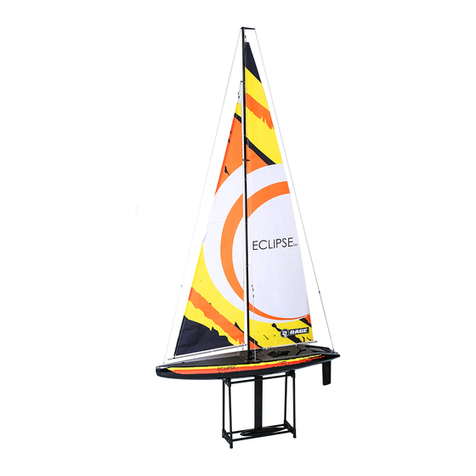
6
However, even before the LVC takes place, if you find that more than typical throle is needed to power the
boat you should drive it back to you and disconnect the baery immediately to avoid over-discharge. It is
NOT recommended that you connue to drive the boat aer LVC occurs or permanent damage to the baery
could occur leading to reduced power and run mes with future use. Note that operaon of the baery is NOT
covered under warranty.
It is also not recommended that you connually run the baery to the “so” LVC with each operaon. You
should be aware of the power level of the baery each me you drive the boat and as soon as you find that it
requires more throle than normal to maintain speed you should drive the boat back to you and disconnect
the baery immediately. Connually running the baery to the soLVC can cause permanent damage to the
baery, so it is best to keep track of your run me and disconnue use prior to reaching the soLVC.
Important Note: Do not leave the baery connected to the ESC unless you are ready to run the
boat. If the baery is leconnected when it is not in use, it will become over-discharged and
the baery will become damaged and unusable.
Important Note: Do not store the baery fully charged
For improved safety and longevity of the baery it is recommended that it be stored parally charged for
any length of me. Storing the Li-ion baery at approximately 50% charged (approximately 3.85V per cell) is
typically best. This will take some management of the charge me and the use of a voltmeter. If you do not
have the equipment or experience to maintain the 50% charge, simply be sure not to store the baery fully
charged whenever possible. In fact, as long as the baery will be stored at approximately room temperature
and for no more than a few weeks before the next use, it is beer to store the baery in the discharged state
aer the last use – as long as it was not over-discharged below the LVC.
LiPo Battery Warning
IMPORTANT NOTE: Lithium Polymer (LiPo) baeries
are significantly more volale than alkaline, NiCd
or NiMH baeries also used in RC applicaons. All
instrucons and warnings must be followed exactly
to prevent property damage and/or personal injury
as mishandling of LiPo baeries can result in fire. By
handling, charging or using the included LiPo baery
you assume all risks associated with LiPo baeries. If
you do not agree with these condions please return
the complete product in new, unused condion to the
place of purchase immediately.
• You MUST charge the LiPo baery in a safe area
away from flammable materials.
• NEVER charge the LiPo baery unaended
at any me. When charging the baery you
should ALWAYS remain in constant observaon
to monitor the charging process and react
immediately to any potenal problems that may
occur.
• Aer discharging the baery you must allow it
to cool to ambient/room temperature before
recharging.
• To charge the LiPo baery you MUST use only the
included balance charger or suitable LiPo baery
charger. Failure to do so may result in a fire
causing property damage and/or personal injury.
DO NOT use a NICD or NIMH charger.
• If at any me during the charge or discharge
process the baery begins to balloon or swell,
disconnue charging or discharging immediately.
Quickly and safely disconnect the baery, then
place it in a safe, open area away from flammable
materials to observe for at least 15 minutes.
Connuing to charge or discharge a baery that
has begun to balloon or swell can result in a fire.
A baery that has ballooned or swollen even a
small amount must be removed from service
completely.




























